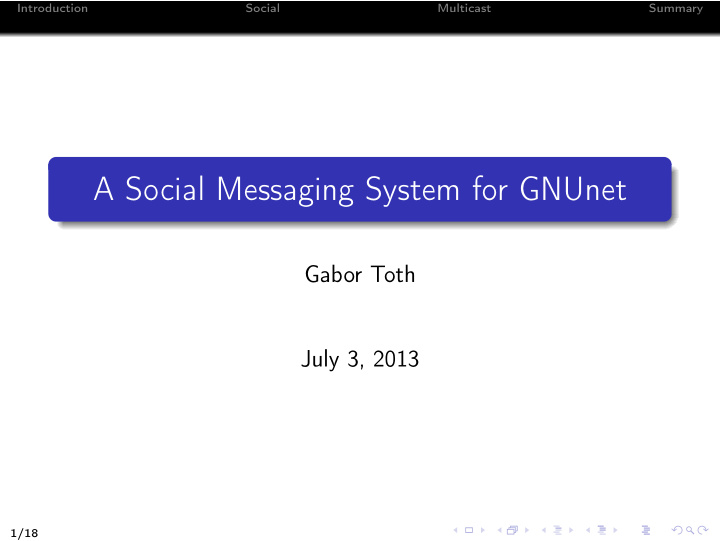



Introduction Social Multicast Summary A Social Messaging System for GNUnet Gabor Toth July 3, 2013 1/18
Introduction Social Multicast Summary Design goals A social messaging system, which is • scalable • extensible • end-to-end encrypted 2/18
Introduction Social Multicast Summary Federated systems • e.g. XMPP, OStatus • they only provide link-level encryption • servers see all communication • large providers see much of the traffic 3/18
Introduction Social Multicast Summary GNUnet • GNU’s Framework for Secure Peer-to-Peer Networking • encrypted communication between peers • GADS: GNU’s Alternative Domain System, offers PKI 4/18
Introduction Social Multicast Summary Social network model • Users can have multiple pseudonyms • Each hosting multiple places, where guests can enter 5/18
Introduction Social Multicast Summary 6/18
Introduction Social Multicast Summary Identities • Pseudonyms and places are identified by an ECC key pair • GADS zone for each pseudonym • the zone is published in the DHT under H ( Nym pub ) • the zone is signed by the pseudonym • PLACE record type for pointing to places • empty label (+) points to a place for initial contact + PLACE H ( PlaceA pub ) tech PLACE H ( PlaceB pub ) music PLACE H ( PlaceC pub ) 7/18
Introduction Social Multicast Summary Place • one-to-many messaging model • host sends messages to guests • guest can send requests to host • hosts decorate their homes • history stored locally • applications handle method calls • messages use the PSYC syntax 8/18
Introduction Social Multicast Summary PSYC syntax • extensible syntax and semantics • method is mandatory, state ops and body are optional :_volume 100 _message_public_shout Hello , world! =_location_city Amsterdam =_location_country Netherlands _notice_profile_location 9/18
Introduction Social Multicast Summary Multicast service • a place is modelled as a multicast group • origin: multicast messages originate from here • group members are peers, no pseudonyms at this level • messages are signed with the place’s key 10/18
Introduction Social Multicast Summary Joining a multicast group • place to origin mapping: H ( PLACE pub ) → H ( PEER pub ) , signed with PLACE priv • look up peer of origin and send a join request there • join request answered by application layer • if admitted, the peer receives a list of other group members to connect, and starts receiving messages 11/18
Introduction Social Multicast Summary Replay 12/18
Introduction Social Multicast Summary Confidentiality • replay only those messages, which the requester could have seen • store join/leave events • group generation: incremented when a member leaves • members are trusted that they only forward messages to the intended recipients 13/18
Introduction Social Multicast Summary Group generation 14/18
Introduction Social Multicast Summary Components of the system • Applications • Social: social network model, try-and-slice • PSYC: parse PSYC syntax and perform state operations • PSYCstore: message history, state, membership • Multicast: messaging and replay in multicast groups 15/18
Introduction Social Multicast Summary 16/18
Introduction Social Multicast Summary Summary • scalability through multicast message delivery • availability: local storage of messages • extensibility provided by the PSYC syntax • ECC keys for nyms & places • GADS for naming 17/18
Introduction Social Multicast Summary Questions? 18/18
Recommend
More recommend